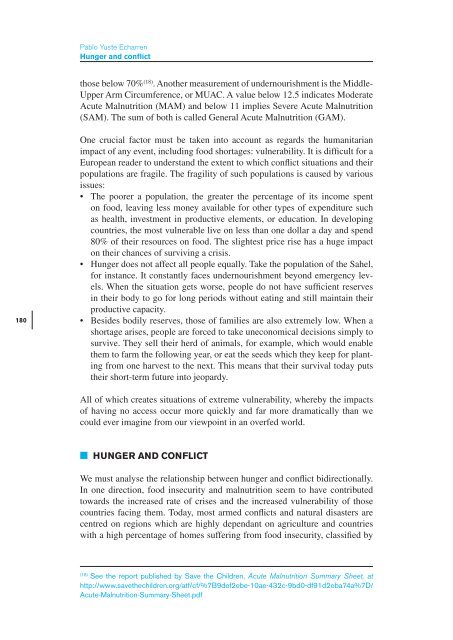Food security and global security - IEEE
Food security and global security - IEEE
Food security and global security - IEEE
- No tags were found...
You also want an ePaper? Increase the reach of your titles
YUMPU automatically turns print PDFs into web optimized ePapers that Google loves.
Pablo Yuste EcharrenHunger <strong>and</strong> conflictthose below 70% (18) . Another measurement of undernourishment is the Middle-Upper Arm Circumference, or MUAC. A value below 12.5 indicates ModerateAcute Malnutrition (MAM) <strong>and</strong> below 11 implies Severe Acute Malnutrition(SAM). The sum of both is called General Acute Malnutrition (GAM).180One crucial factor must be taken into account as regards the humanitarianimpact of any event, including food shortages: vulnerability. It is difficult for aEuropean reader to underst<strong>and</strong> the extent to which conflict situations <strong>and</strong> theirpopulations are fragile. The fragility of such populations is caused by variousissues:• The poorer a population, the greater the percentage of its income spenton food, leaving less money available for other types of expenditure suchas health, investment in productive elements, or education. In developingcountries, the most vulnerable live on less than one dollar a day <strong>and</strong> spend80% of their resources on food. The slightest price rise has a huge impacton their chances of surviving a crisis.• Hunger does not affect all people equally. Take the population of the Sahel,for instance. It constantly faces undernourishment beyond emergency levels.When the situation gets worse, people do not have sufficient reservesin their body to go for long periods without eating <strong>and</strong> still maintain theirproductive capacity.• Besides bodily reserves, those of families are also extremely low. When ashortage arises, people are forced to take uneconomical decisions simply tosurvive. They sell their herd of animals, for example, which would enablethem to farm the following year, or eat the seeds which they keep for plantingfrom one harvest to the next. This means that their survival today putstheir short-term future into jeopardy.All of which creates situations of extreme vulnerability, whereby the impactsof having no access occur more quickly <strong>and</strong> far more dramatically than wecould ever imagine from our viewpoint in an overfed world.■■HUNGER AND CONFLICTWe must analyse the relationship between hunger <strong>and</strong> conflict bidirectionally.In one direction, food in<strong>security</strong> <strong>and</strong> malnutrition seem to have contributedtowards the increased rate of crises <strong>and</strong> the increased vulnerability of thosecountries facing them. Today, most armed conflicts <strong>and</strong> natural disasters arecentred on regions which are highly dependant on agriculture <strong>and</strong> countrieswith a high percentage of homes suffering from food in<strong>security</strong>, classified by(18)See the report published by Save the Children, Acute Malnutrition Summary Sheet, athttp://www.savethechildren.org/atf/cf/%7B9def2ebe-10ae-432c-9bd0-df91d2eba74a%7D/Acute-Malnutrition-Summary-Sheet.pdf
















